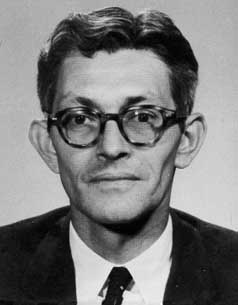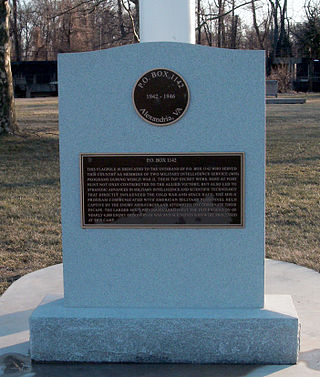Related Research Articles
Espionage, spying, or intelligence gathering is the act of obtaining secret or confidential information (intelligence). A person who commits espionage is called an espionage agent or spy. Any individual or spy ring, in the service of a government, company, criminal organization, or independent operation, can commit espionage. The practice is clandestine, as it is by definition unwelcome. In some circumstances, it may be a legal tool of law enforcement and in others, it may be illegal and punishable by law.

The Office of Strategic Services (OSS) was the intelligence agency of the United States during World War II. The OSS was formed as an agency of the Joint Chiefs of Staff (JCS) to coordinate espionage activities behind enemy lines for all branches of the United States Armed Forces. Other OSS functions included the use of propaganda, subversion, and post-war planning.

Cold War espionage describes the intelligence gathering activities during the Cold War between the Western allies and the Eastern Bloc. Both relied on a wide variety of military and civilian agencies in this pursuit.

Operation Paperclip was a secret United States intelligence program in which more than 1,600 German scientists, engineers, and technicians were taken from the former Nazi Germany to the U.S. for government employment after the end of World War II in Europe, between 1945–59. Some were former members and leaders of the Nazi Party.

James Jesus Angleton was an American intelligence operative who served as chief of the counterintelligence department of the Central Intelligence Agency from 1954 to 1975. According to Director of Central Intelligence Richard Helms, Angleton was "recognized as the dominant counterintelligence figure in the non-communist world".

Reinhard Gehlen was a German career intelligence officer who served the Weimar Republic, Nazi Germany, the U.S. intelligence community, and the NATO-affiliated Federal Republic of Germany during the Cold War.
Operation Gladio was the codename for clandestine "stay-behind" operations of armed resistance that were organized by the Western Union (WU), and subsequently by NATO and by the CIA, in collaboration with several European intelligence agencies during the Cold War. Although Gladio specifically refers to the Italian branch of the NATO stay-behind organizations, Operation Gladio is used as an informal name for all of them. Stay-behind operations were prepared in many NATO member countries, and in some neutral countries.

The United States Office of War Information (OWI) was a United States government agency created during World War II. The OWI operated from June 1942 until September 1945. Through radio broadcasts, newspapers, posters, photographs, films and other forms of media, the OWI was the connection between the battlefront and civilian communities. The office also established several overseas branches, which launched a large-scale information and propaganda campaign abroad. From 1942 to 1945, the OWI revised or discarded any film scripts reviewed by them that portrayed the United States in a negative light, including anti-war material.

Operation Sunrise was a series of World War II secret negotiations from February to May 1945 between representatives of Nazi Germany and the United States to arrange a local surrender of German forces in northern Italy. Most of the meetings took place in the vicinity of Bern, Switzerland, and the lead negotiators were Waffen-SS General Karl Wolff and American OSS agent Allen Dulles. The meetings provoked Soviet suspicion that the Americans were seeking to sign a separate peace with the Germans and led to heated correspondence between Joseph Stalin and Franklin Roosevelt, an early episode of the emerging Cold War.

Krunoslav Stjepan Draganović was a Bosnian Croat Catholic priest associated with the ratlines which aided the escape of Ustaše war criminals from Europe after World War II while he was living and working at the College of St. Jerome in Rome. He was an Ustaša and a functionary in the fascist puppet state called the Independent State of Croatia.

The Counter Intelligence Corps was a World War II and early Cold War intelligence agency within the United States Army consisting of highly trained special agents. Its role was taken over by the U.S. Army Intelligence Corps in 1961 and, in 1967, by the United States Army Intelligence Agency. Its functions are now performed by its modern-day descendant organization, United States Army Counterintelligence. The National Counter Intelligence Corps Association (NCICA), a veterans' association, was established in the years immediately following World War II by former military intelligence agents.

Annie Jacobsen is an American investigative journalist, author, and a 2016 Pulitzer Prize finalist. She writes for and produces television programs, including Tom Clancy's Jack Ryan for Amazon Studios, and Clarice for CBS. She was a contributing editor to the Los Angeles Times Magazine from 2009 until 2012. Jacobsen writes about war, weapons, security, and secrets. Jacobsen is best known as the author of the 2011 non-fiction book, Area 51: An Uncensored History of America's Top Secret Military Base, which The New York Times called "cauldron-stirring." She is an internationally acclaimed and sometimes controversial author who, according to one critic, writes sensational books by addressing popular conspiracies.
The aftermath of World War II saw the rise of two global superpowers, the Soviet Union (USSR) and the United States (US). The aftermath of World War II was also defined by the rising threat of nuclear warfare, the creation and implementation of the United Nations as an intergovernmental organization, and the decolonization of Asia and Africa by European and East Asian powers, most notably by the United Kingdom, France, and Japan.

P.O. Box 1142 was a secret American military intelligence facility that operated during World War II. The American Military Intelligence Service had two special wings, known as MIS-X and MIS-Y.
While the United States was involved in the prosecution of people involved in the war crimes of World War II, US military and intelligence agencies protected some war criminals in the interest of obtaining technical or intelligence information from them, or to recruit them for intelligence work. The relationships with German war criminals started immediately after the end of the Second World War, but some of the relationships with Japanese war criminals were slower to develop.
At various times, under its own initiative or in accordance with directives from the President of the United States or the National Security Council staff, the Central Intelligence Agency (CIA) has attempted to influence public opinion both in the United States and abroad.
Operation Osoaviakhim was a secret Soviet operation under which more than 2,500 former Nazi German specialists from companies and institutions relevant to military and economic policy in the Soviet occupation zone of Germany (SBZ) and Berlin, as well as around 4,000 more family members, totalling more than 6,000 people, were transported from former Nazi Germany as war reparations to the Soviet Union. It took place in the early morning hours of October 22, 1946 when MVD and Soviet Army units under the direction of the Soviet Military Administration in Germany (SMAD), headed by Ivan Serov, rounded up German scientists and transported them by rail to the USSR.
Carmel Offie was a U.S. State Department and later a Central Intelligence Agency (CIA) official. He was dismissed from the CIA in 1950 after an arrest a few years earlier brought his homosexuality to the attention of Senator Joseph McCarthy during the Lavender scare that saw a purge of the State Department personnel because of charges of homosexuality.
The Report on the Covert Activities of the Central Intelligence Agency is a 69-page formerly classified comprehensive study on the personnel, security, adequacy, and efficacy of the Central Intelligence Agency written by Lieutenant General James H. Doolittle. United States President Dwight Eisenhower requested the report in July 1954 at the height of the Cold War and following coups in Iran and Guatemala. The report compares with other contemporary Cold War documents such as George Kennan's "X" article in Foreign Affairs, which recommended a policy of "containment" rather than direct confrontation with the Soviet Union, and NSC 68, the secret policy document produced in 1950, which recommended a similarly restrained policy of “gradual coercion.” Doolittle wrote with an abandon-all-principles approach that conveyed the national fear that the United States faced the prospect of annihilation at the hands of the Soviet Union: “It is now clear that we are facing an implacable enemy whose avowed objective is world domination by whatever means and at whatever cost,” Doolittle wrote. “There are no rules in such a game… If the United States is to survive, long standing concepts of ‘fair play’ must be reconsidered.” Doolittle’s forceful policy and language reflected the fear that motivated American citizens and policymakers in the wake of Soviet Communism.

The People's Commissariat for Internal Affairs, abbreviated NKVD, was the interior ministry of the Soviet Union.
References
- ↑ Valentine, Douglas (2004). The Strength of the Wolf: The Secret History of America's War on Drugs. Verso. p. 100. ISBN 9781859845684.
- ↑ Wilford, Hugh (2009). The Mighty Wurlitzer: How the CIA Played America. Harvard University Press. pp. 29–30. ISBN 9780674045170.
- ↑ Simpson, Christopher (2014-06-10). Blowback: America's Recruitment of Nazis and Its Destructive Impact on Our Domestic and Foreign Policy. Open Road Media. ISBN 9781497623064.
- ↑ Gerolymatos, Andre (2010). Castles Made of Sand: A Century of Anglo-American Espionage and Intervention in the Middle East. Macmillan. p. 144. ISBN 9781429913720.
- ↑ Dionisi, David J. (2011). Vigilant Christian II: Preventing an American Hiroshima. Trafford Publishing. ISBN 9781426993756.